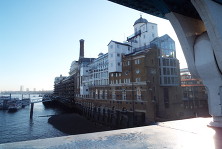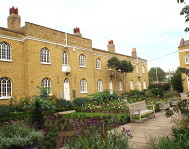








The vestry of St Giles reached agreement to build a workhouse for the poor who called upon parish funds in 1727. This was a radical change towards the treatment and support for those unable to support themselves who the parish, prior to the building of the workhouse, helped to maintain in their own homes. Many aspects were considered: whether it would be beneficial to concentrate the poor in one “local habitation” within the parish, whether it would encourage those who sometimes needed support to become permanently in need from the parish, whether it would form an attraction to those passing through the parish, and by no means the least consideration, how the cost to the parish for maintaining the poor might be lessened.
It was noted that the workhouse system had been successful in other parishes and St Giles Vestry decided that by building a house for the reception of the poor where they would be set to work would promote industry within the poor and lessen the charge to the parish so, it was said, would be beneficial to both the parish and the poor. The workhouse was built on the site known today as 29 Peckham Road which had been donated to the parish by Sir William Bowyer. Next to the workhouse was a low building that housed the “parish squirt”, rudimentary fire fighting equipment, and in front of the main gates stood The Stocks.
In 1771 it was necessary to build an additional wing to accommodate the increasing numbers of paupers and by 1815, though the vestry was reluctant to spend such a large sum, it had become necessary to build a new workhouse to accommodate the still growing numbers. This was built on land behind the original workhouse and fronting on to Havil Street, then called Workhouse Lane. The land was conveyed to the parish by Sir William Smyth. The old workhouse was demolished and the (old) Vestry Hall built on the site.
The new workhouse was a long narrow building, two storeys high, and enlarged in 1849. The Lancet visited and reported on London workhouse infirmaries in 1865/66. When they visited the Havil Street workhouse, there were a total of 382 inmates and though the workhouse was built to accommodate 550 inmates, even with this smaller number, it appeared full. Of these 382 inmates, most – 346 – fell into the category of aged or infirm and the Lancet report stated that
“ought, all of them, to be considered as under medical care, since their declining health demands skilful supervision and nursing. The infirm wards, like those for the sick, are very deficient in superficial space, light, and ventilation, and we believe this to be a great misfortune. Many of these infirm persons, by receiving proper medical attendance and suitable comforts, might be rescued from their life-long invalidism, and placed in circumstances of improved health, which would benefit not merely themselves, but even the interests of the ratepayers, while the guardians would doubtless derive pleasure from the execution of an important duty.” (workhouses.org)
The Lancet’s recommendations included that the infirmary ought to be immediately rebuilt or greatly modified, that the old and infirm ought to be classed and treated as sick, trained and paid nurses should be appointed to care for the sick and the status and pay of the medical officer should be reconsidered.
One section of the workhouse was praised by the Lancet, the new building for imbeciles which was well lit and ventilated, the wards carpeted down the middle and the walls tinted with pictures and scripture texts. Various outdoor and indoor amusements were provided “arrangements which are as commendable as they are unusual.”
A new infirmary was built in 1873 and was referred to by Mr Blanch as a “splendid building” it formed “a large square block, covering an area of 1,900 square yards, and an area enclosed by the main frontage and wings of the building give to it within the character of a quadrangle.” The basement contained dispensary rooms, consulting rooms, patients’ waiting rooms, the laundry, kitchens, beer and wine cellars, wash-house, engine house and boiler. The main building was five storeys high and housed both public and private accommodation for the surgeons, matron and nurses while the top two floors contained special wards. The two three storey wings consisted of wards, women’s wards in the south wing and men’s wards in the north wing. The wings accommodated 168 patients and together with the special wards, the infirmary was able to accommodate a total of 300 patients.
Havil Street Workhouse and Infirmary
The building at 29 Peckham Road on the western corner of Peckham Road and Havil Street is Grade II listed and in the Edwardian baroque style. At high level, over the entrance, there is a sundial with the message to “Do today’s work today” and below a carved sign that names the building “Guardian’s Offices 1904”, reminders of the building’s connection to the workhouse in Camberwell, or the Havil Street Hotel as the St Giles workhouse was known locally in the 19th century.
In 1890 the wonderful circular ward building was added. On each of the four storeys there were 24 beds radiating around a central shaft like spokes in a wheel. Further enlargement was made to the infirmary at the turn of the century with the addition of more ward blocks, an operating theatre, a nurses’ home and an administration block.
The Vestry Hall, built on the site of the original workhouse, had been superseded in 1872 with the opening of a new Vestry Hall on the corner opposite. The old vestry hall was demolished and the Board of Guardian’s Offices – 29 Peckham Road – built on the site in 1904.
As the Havil Street site became more concerned with the care of the old, the sick and the infirm, a new workhouse for the able bodied was opened in Gordon Road in 1878. A further workhouse was opened in 1895 at the end of Constance Road in East Dulwich that housed 1,000 inmates who were mostly aged and infirm, and a relief station was also opened in Consort Road, Nunhead in 1901 where claims were made for poor relief and out-relief issued.
The infirmary in Havil Street became known as the Camberwell Parish Infirmary in 1913 and in 1930 was taken over by the London County Council. It became a part of the NHS on its formation in 1948 and renamed St Giles’ Hospital, and became part of King’s College Group in 1967. The hospital closed in 1983 and most of the former hospital buildings have now been converted to residential, including the circular ward building which has been renamed St Giles Tower and is now Grade II listed. The Constance Road site also came under the LCC after 1930 and renamed St Francis Hospital (and Constance Road became St Francis Road). It became a part of Dulwich Hospital but was closed in 1982. The Constance Road buildings were demolished and a small private estate of two-storey houses built and named the St Francis estate.
When St Giles Hospital closed, the Guardians' Offices became offices for Southwark Council until 2010 and is now home to the Thames Reach Employment Academy a well established charity that provides support and training for the long term unemployed.
Sources: H Blanch (1877) Ye Parish of Camerwell
Web discoveries
- UK Casino Not On Gamstop
- UK Casino Not On Gamstop
- Non Gamstop Casino
- Casinos Not On Gamstop
- Non Gamstop Casinos
- Non Gamstop Casinos
- Non Gamstop Casino
- Casino Sites Not On Gamstop
- Slots Not On Gamstop
- Casinos Not On Gamstop
- UK Betting Sites Not On Gamstop
- UK Casino Not On Gamstop
- Best Non Gamstop Casinos
- Betting Sites
- Non Gamstop Casino Sites UK
- Best Non Gamstop Casinos
- Non Gamstop Casino
- Casinos Not On Gamstop
- Non Gamstop Casino Sites UK